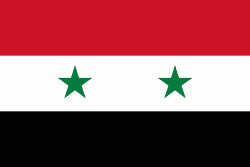Salqin (Salqīn)
Salqin (سَلْقِين) is a town in Syria, administratively part of Idlib Governorate. Nearby localities include Kafr Takharim to the southeast, Abu Talha to the south, Delbiya to the southwest, al-Alani to the northwest and Isqat to the northeast. Salqin is the center of its nahiya (subdistrict). It had a population of 23,700 in 2004. Its inhabitants are predominantly Sunni Muslims, although there is also a small Alawite community.
The town is situated in the southern Orontes River valley and has an altitude of 460 meters above sea level. Olive and other fruit trees surround Salqin. It exports produce from these orchards as well as vegetables. Agriculture is sustained by the large number of springs in Salqin.
According to legends, the city was the summer residence of Seleucus I, hence the naming. An inscription, found on a stone between two cypress trees in the village, dates its foundation to 98 BC.
Salqin was mentioned by medieval Muslim historian Izz al-Din ibn Shaddad al-Halabi as the site of one of 22 abandoned or ruined fortresses in the Aleppo region, likely disbanded or destroyed during the Mongol invasions of Syria in the mid to late 13th century. The Mamluks who gained power in the region at that time did not rebuild the fortress in Salqin.
A former education minister and two former governors of Homs and Raqqah were from Salqin. In November 2012, during the Syrian civil war, Syrian rebels captured the town from government forces. According to anti-government activists, around 70% of Salqin's residents still supported the government of Bashar al-Assad in January 2013. This led to tensions, and the killing of a number of pro-Assad activists. sides.
The town is situated in the southern Orontes River valley and has an altitude of 460 meters above sea level. Olive and other fruit trees surround Salqin. It exports produce from these orchards as well as vegetables. Agriculture is sustained by the large number of springs in Salqin.
According to legends, the city was the summer residence of Seleucus I, hence the naming. An inscription, found on a stone between two cypress trees in the village, dates its foundation to 98 BC.
Salqin was mentioned by medieval Muslim historian Izz al-Din ibn Shaddad al-Halabi as the site of one of 22 abandoned or ruined fortresses in the Aleppo region, likely disbanded or destroyed during the Mongol invasions of Syria in the mid to late 13th century. The Mamluks who gained power in the region at that time did not rebuild the fortress in Salqin.
A former education minister and two former governors of Homs and Raqqah were from Salqin. In November 2012, during the Syrian civil war, Syrian rebels captured the town from government forces. According to anti-government activists, around 70% of Salqin's residents still supported the government of Bashar al-Assad in January 2013. This led to tensions, and the killing of a number of pro-Assad activists. sides.
Map - Salqin (Salqīn)
Map
Country - Syria
 |
 |
| Flag of Syria | |
The name "Syria" historically referred to a wider region, broadly synonymous with the Levant, and known in Arabic as al-Sham. The modern state encompasses the sites of several ancient kingdoms and empires, including the Eblan civilization of the 3rd millennium BC. Aleppo and the capital city Damascus are among the oldest continuously inhabited cities in the world. In the Islamic era, Damascus was the seat of the Umayyad Caliphate and a provincial capital of the Mamluk Sultanate in Egypt. The modern Syrian state was established in the mid-20th century after centuries of Ottoman rule. After a period as a French mandate (1923–1946), the newly-created state represented the largest Arab state to emerge from the formerly Ottoman-ruled Syrian provinces. It gained de jure independence as a democratic parliamentary republic on 24 October 1945 when the Republic of Syria became a founding member of the United Nations, an act which legally ended the former French mandate (although French troops did not leave the country until April 1946).
Currency / Language
| ISO | Currency | Symbol | Significant figures |
|---|---|---|---|
| SYP | Syrian pound | £ or لس | 2 |
| ISO | Language |
|---|---|
| AR | Arabic language |
| HY | Armenian language |
| EN | English language |
| FR | French language |
| KU | Kurdish language |















